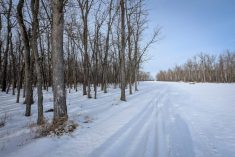Southern Alberta has had quite a beating from Mother Nature this summer. The hail season started early with crop-damaging hailstorms during the last week of May in both Lethbridge and Vulcan areas.
Storms were particularly violent and widespread over July 5-8, when some motorists reported driving through hailstorms as tough as any winter storm and parts of Highway 2 north of Claresholm had just tire tracks to guide them through the hailstones covering the driving lanes. Taber received over 50 mm of moisture as rain and hail in less than an hour and streets flooded as hailstones blocked grates on storm sewers.
Read Also

Feed Grain Weekly: Quiet trade to close the year
Feed grain prices are not expected to change drastically in the coming months, said a Saskatchewan-based trader.
In the week following the storms, phones at Agriculture Financial Services Corporation (AFSC) in Lethbridge were ringing off the hook as people called to report crop-damaging storms. “It looks very severe,” said Marilyn Smith, acting area manager for sales and marketing at AFSC branch operations in the southern region. “Just today, we’ve had over 100 calls. And, a lot of people will go and check things for themselves before they call us.”
Smith said almost every county south of Calgary has had some damaging hailstorms, even those that are normally dry, like Cypress (Medicine Hat) and Forty Mile. Special crops have been hit hard, so the storms could be very costly.
“Potatoes and sugar beets might come back and produce a reasonable yield,” said Smith. “But this year certainly isn’t shaping up to be the year it looked to be in spring for a lot of crops.”
Brian Tainsh, manager of farm inspections for AFSC, said “things have been wild in the south,” with Lethbridge, Taber and Medicine Hat areas pounded hard.
“Storms have spread northwards as well. We have had storms throughout the province, but it’s by far the worst in the south. We’ve got some big crews working down there to assess the damage”
Tainsh said some areas have been hit twice.
“We’ve been working on one storm and we’ve had to stop and start over because it’s been hit again,” he said.
Moisture levels have been high, especially in southern parts of the province. High temperatures and high moisture levels lead to hailstorms, says Tainsh. High temperatures early in the year led to severe hailstorms earlier than usual. Lethbridge and Vulcan areas had hail the last week of May and again in early June.
“The last couple of years, everything has been looking pretty good,” said Tainsh. “We’ve had good rainfall and good process for just about every crop, but you can never outguess Mother Nature.”
Although some of the storms have hit big areas and some high-value specialty crops look badly damaged, Tainsh says it’s not a really bad hail year across the whole province. “Damage looks to be a little higher than average this year, overall,” he says. “But, it’s not like last year. Last year we had only 11 hail-free days between early June and mid-September and the storms were spread from one end of the province to the other,” he said.
“This year is bad and it’s always devastating for someone who’s put so much into a crop to lose it. But, this year is still nothing like last year.”
In 2012, AFSC processed over 11,000 claims totaling $450 million, the worst year ever. The previous most damaging year was 2008, when about $265 million was paid out in claims. “Of course, crops are a long way from the bin yet. We have to keep hoping for some good weather for the rest of the crops,” Tainsh said.














